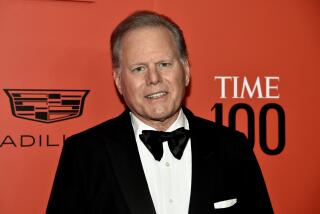Time Warner’s third-quarter earnings beat analysts’ estimates
Time Warner beat Wall Street estimates of its third-quarter earnings, providing support for the company’s strategy to remain independent by fending off Rupert Murdoch’s advances last summer.
Despite a weaker performance for Warner Bros. at the box office and ratings declines at several Turner Broadcasting cable channels, Time Warner’s revenue rose 3% to $6.24 billion in the July-September quarter.
“We had another quarter of strong revenue growth,” Time Warner Chief Executive Jeff Bewkes told analysts on an conference call after the company reported its results Wednesday.
Subscription fees from pay-TV affiliates increased 10%.
Profit fell 18% to $967 million. Excluding the costs of severance packages and a sizable tax benefit, third-quarter earnings came in at 97 cents a share. Analysts had predicted earnings of 94 cents.
The company also increased its full-year business outlook.
“We’re executing on our longer-range plans to go after the large and growing global opportunity we see in video content,” Bewkes said.
Time Warner shares were trading up $2.22, or 3%, at $77.19 after the earnings were released.
The company took $400 million in charges for severance packages and restructuring as the company dramatically reduces its workforce. The charges will be spread into the fourth quarter.
Time Warner is cutting about 2,600 employees -- roughly 10% of its workforce. The cuts include around 1,000 in the Burbank-based Warner Bros. film and TV studio, where layoffs began this week.
The company said the cost savings from the job cuts would reach $450 million, with much of the benefit landing next year.
During the quarter, the company’s Turner Broadcasting unit, which includes the TNT, TBS, CNN and Cartoon Network channels, took a massive $482-million programming write-down for reruns of “The Mentalist,” and other shows that crashed and burned.
The company said it needed to be more selective in the off-network reruns it orders. Turner also had higher programming costs due to higher Major League Baseball rights fees.
Turner revenue increased 5% to $2.4 billion. The unit benefited from higher fees charged to cable and satellite TV operators to carry the Turner channels. Operating income plummeted 65% to $337 million.
“Advertising dipped a bit more than anticipated,” Wells Fargo Securities analyst Marci Ryvicker noted in a report about the earnings.
Warner Bros. film and TV studio revenue grew 3% to $2.8 billion, which the company attributed to subscription video-on-demand services writing big checks for its TV shows and higher license fees for its movies.
But the studio’s results experienced a drag from softer movie ticket sales. The studio released “Tammy,” “If I Stay,” and “Into the Storm,” during the quarter.
Those films were no match for “Pacific Rim,” “The Conjuring,” and “We’re the Millers,” which the studio released in the third quarter of 2013.
Studio operating income declined 23% to $237 million.
HBO had a strong quarter, trumping Wall Street’s expectations. The premium channel business is on track for its best year in decades.
Revenue increased 10% to $1.3 billion. However, operating income declined 24% to $380 million, in part, because of a one-time gain in the year-earlier period.
Time Warner made a splash last month by saying it would unbundle its HBO service and offer a stand-alone Internet streaming product.
Some competitors have said HBO might find the stand-alone product business more challenging than it anticipates.
Bewkes made a point to say Time Warner was not trying to compete with its traditional partners. The HBO over-the-top product is not intended to unravel the pay-TV bundle, he said. Instead, it will be primarily targeted at people who live in the 10 million homes in the U.S. that do not subscribe to pay TV.
“We can’t ignore the growing opportunity outside the TV ecosystem,” Bewkes said. He added that Time Warner was an industry leader in high-quality content, spending $14 billion a year on programming and marketing.
Twitter: @MegJamesLAT
More to Read
From the Oscars to the Emmys.
Get the Envelope newsletter for exclusive awards season coverage, behind-the-scenes stories from the Envelope podcast and columnist Glenn Whipp’s must-read analysis.
You may occasionally receive promotional content from the Los Angeles Times.







